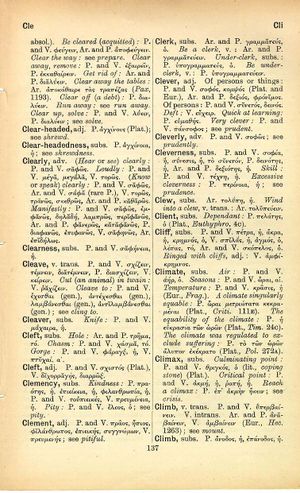climax: Difference between revisions
From LSJ
Ψυχῆς μέγας χαλινὸς ἀνθρώποις ὁ νοῦς → Animi nam frenum magnum mens est hominibus → Der Menschenseele fester Zügel ist Vernunft
(CSV3) |
(6_3) |
||
| Line 7: | Line 7: | ||
<b class="b2">Reach a climax</b>: P. ἐπʼ ἀκμὴν ἥκειν; see [[crisis]]. | <b class="b2">Reach a climax</b>: P. ἐπʼ ἀκμὴν ἥκειν; see [[crisis]]. | ||
}} | |||
{{Lewis | |||
|lshtext=<b>clīmax</b>: ăcis, f., = [[κλῖμαξ]]> (a [[ladder]]),<br /><b>I</b> a [[rhetorical]] [[figure]], consisting in a [[gradual]] [[increase]] in [[force]] of [[expression]], a [[climax]] ([[pure]] Lat. [[gradatio]]), Mart. Cap. 5, § 536 (in Quint. 9, 3, 54, used as Greek, and transl. by [[gradatio]]). | |||
}} | }} | ||
Revision as of 08:25, 13 August 2017
English > Greek (Woodhouse)
subs.
Culminating point: P. and V. θριγκός, ὁ (lit., coping stone) (Plat.).
Critical point: P. and V. ἀκμή, ἡ, ῥοπή, ἡ.
Reach a climax: P. ἐπʼ ἀκμὴν ἥκειν; see crisis.
Latin > English (Lewis & Short)
clīmax: ăcis, f., = κλῖμαξ> (a ladder),
I a rhetorical figure, consisting in a gradual increase in force of expression, a climax (pure Lat. gradatio), Mart. Cap. 5, § 536 (in Quint. 9, 3, 54, used as Greek, and transl. by gradatio).

